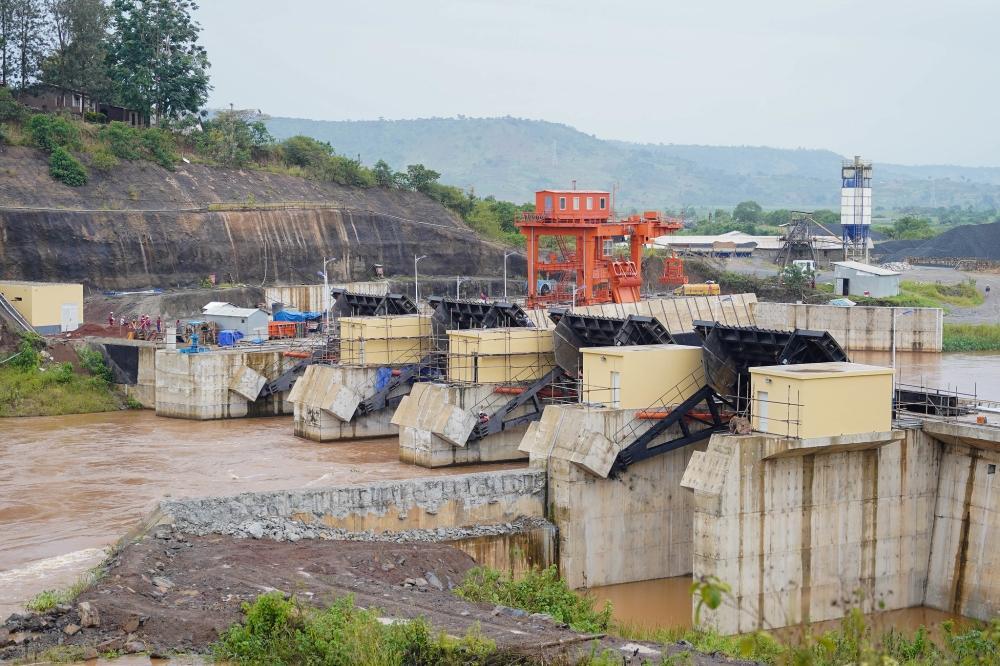Africa-Press – Rwanda. Rwanda is constructing housing units in Kirehe District in the Eastern Province for households affected by blasting during the implementation of the Rusumo hydropower project on the Rwanda–Tanzania border.
Blasting, a method of rock excavation, is frequently used in hydropower plant development to excavate tunnels, create dams, and clear land for construction.
During the construction of the 80-megawatts power plant, tens of households were affected by this exercise. As a result, the parliament asked project developers to compensate those affected.
“We are constructing housing units for 80 households. These include facilities such as water, electricity, drainage, internal and connecting roads, cow sheds, and an early childhood development centre. The model village is situated near the border, where they work and live ,” Bruno Rangira, Mayor of Kirehe District, told The New Times.
The ongoing construction project of housing blocks to accommodate households affected by blasting in Kirehe. Courtesy
Nile Equatorial Lakes Subsidiary Action Programme – established under Nile Basin Initiative (NBI) which comprises 10 countries in Nile River Basin – together with Kirehe District and the Ministry of Infrastructure are jointly implementing the project
In March 2024, Members of Parliament in Rwanda gave a six-month deadline for the construction of the affected homes.
Anthony Shumbusho, Environmental Compliance Inspector for the Nile Equatorial Lakes Subsidiary Action Programme (NELSAP-CU), said that following claims from affected households, a committee was formed—comprising the Rwanda Housing Authority, Kirehe District, Police, and others—to fast-track the construction of the housing units.
“The team assessed each house of those who submitted claims and presented the report to us. The report identified homes in critical condition, requiring relocation and the provision of new housing,” he explained.
“As a result, 80 households are to receive new homes, and an additional 14 households, who owned land elsewhere, will have houses built on their plots,” he added.
According to Shumbusho, at least $4.2 million (approximately Rwf6 billion) has been allocated for the construction of the houses and associated facilities.
“The construction was slightly delayed as the district was reviewing the master plan. Currently, construction works are 50 per cent complete. The houses also include annexes,” he NOTED.
The model village is also connected to electricity.
Rusumo power plant
Rusumo hydropower plant is currently generating electricity for Rwanda, Tanzania, and Burundi. The power grids of the three countries have been fully interconnected, allowing for electricity trading.
The transmission line to Burundi runs 160 kilometres from Rusumo to Muyinga and onwards to Gitega.
For Rwanda, the line spans 118 kilometres from Rusumo through Bugesera to Shango, while the Tanzanian line runs 94 kilometres from Rusumo to Nyakanazi.
Burundi’s peak power demand averages 90 megawatts, so receiving 27 megawatts from Rusumo represents a significant portion of lower-cost electricity, according to project developers.
Rwanda’s peak power demand, the highest level of electricity consumption, averages 250 megawatts, making an additional 27 megawatts technically substantial.
Tanzania, on the other hand, has a peak demand exceeding 1,000 megawatts.
Rwanda energy capacity
With the additional 27 megawatts generated from the Akagera River, which runs through the three countries, Rwanda’s total electricity generation capacity has reached 556 megawatts.
Akagera is one of the sources of the Nile River, flowing into Lake Victoria.
The main structures of the Rusumo power plant are located at the Rusumo border between Rwanda and Tanzania, with the switchyard situated on the Rwandan side.
The project is also expected to supply electricity to Bugesera International Airport.
On the Rwandan side, it includes the rehabilitation of 30 kilometres of feeder roads in Kirehe District, construction of 28.7 kilometres of roads in Ngoma District, a water pipeline to supply 10,500 people in Gatonde–Gahima cells, a 33-kilometre Gituku–Murama water supply system, and the construction of 9.54 kilometres of the Kigabiro–Rurenge–Gatore feeder road, among other developments.
For More News And Analysis About Rwanda Follow Africa-Press






